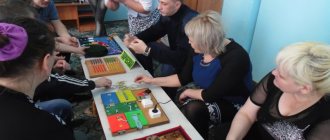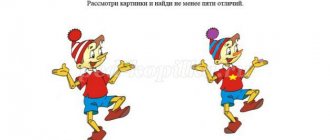The meaning of the game for preschoolers
A game is a huge bright window through which a life-giving stream of ideas and concepts about the world around us flows into the child’s spiritual world.
V. A. Sukhomlinsky
Preschool childhood is a short but important period of personality development. During these years, the child acquires initial knowledge about the life around him, he begins to form a certain attitude towards people, towards work, develops skills and habits of correct behavior, and develops a character.
The main activity of preschool age is play, during which the child’s spiritual and physical strength develops; his attention, memory, imagination, discipline, dexterity. In addition, play is a unique way of learning social experience, characteristic of preschool age.
A. M. Gorky expressed the idea: “Game is the way for children to understand the world in which they live and which they are called upon to change.”
In the game, all aspects of the child’s personality are formed, significant changes occur in his psyche, preparing the transition to a new, higher stage of development. This explains the enormous educational potential of games, which psychologists consider the leading activity of a preschooler.
A special place is occupied by games that are created by children themselves - they are called creative or role-playing games. In these games, preschoolers reproduce in roles everything that they see around them in the life and activities of adults. Creative play most fully shapes a child’s personality, and therefore is an important means of education.
What gives the right to call play a creative activity?
The game is a reflection of life. Everything here is “as if”, “make-believe”, but in this conditional environment, which is created by the child’s imagination, there is a lot of reality; the actions of the players are always real, their feelings and experiences are genuine and sincere. The child knows that the doll and the bear are just toys, but he loves them as if they were alive, understands that he is not a “true” pilot or sailor, but feels like a brave pilot, a brave sailor who is not afraid of danger, and is truly proud of his victory.
Imitating adults in play is associated with the work of the imagination. The child does not copy reality; he combines different impressions of life with personal wholesale.
Children's creativity is manifested in the concept of the game and in the search for means for its implementation. How much creativity is required to decide what journey to take, what ship or plane to build, what equipment to prepare! In the game, children simultaneously act as playwrights, prop makers, decorators, and actors. However, they do not hatch a plan, do not prepare for a long time to play a role, like actors. They play for themselves, expressing their dreams and aspirations, thoughts and feelings that possess them at the moment. Therefore, the game is always improvisation.
Play is an independent activity in which children first interact with peers. They are united by a single goal, joint efforts to achieve it, common interests and experiences.
Children choose the game themselves and organize it themselves. But at the same time, in no other activity are there such strict rules, such conditioning of behavior as here.
Therefore, the game accustoms children to subordinate their actions and thoughts to a specific goal and helps to cultivate purposefulness.
In play, the child begins to feel like a member of a team and fairly evaluates the actions and actions of his comrades and his own. The teacher’s task is to focus the attention of the players on goals that would evoke a commonality of feelings and actions, the ability to establish relationships between children based on friendship, justice, and mutual responsibility.
Creative collective play is a school for educating the feelings of preschoolers. Moral feelings formed in the game influence the child’s behavior in life, while at the same time, the skills developed in the process of children’s everyday communication with each other and with adults are further developed in the game.
Play is an important means of mental education for a child. The knowledge gained in kindergarten and at home finds practical application and development in the game. Reproducing various life events, episodes from fairy tales and stories, the child reflects on what he saw, what was read and told to him; the meaning of many phenomena, their meaning becomes more clear to him.
Translating life experiences into a game is a complex process. Creative play cannot be subordinated to narrow didactic goals; with its help, the most important educational tasks are solved. Children choose their playing role in accordance with their interests and their dreams about their future profession. They are still childishly naive and will change more than once, but it is important that the child dreams of participating in work useful to society. Gradually, through play, the child develops general ideas about the meaning of work and the role of various professions.
In play, children's mental activity is always associated with the work of their imagination; It’s tedious to find a role for yourself, imagine how the person you want to imitate acts, what he says. Imagination also manifests itself and develops in the search for means to carry out the plan; before you go on a flight, you need to build an airplane, you need to select suitable goods for the store, and if there are not enough of them, you need to make it yourself. This is how the game develops the creative abilities of the future schoolchild.
Interesting games create a cheerful, joyful mood, make children’s lives complete, and satisfy their need for active activities. Even in good conditions, with adequate nutrition, the child will develop poorly and become lethargic if he is deprived of an exciting game.
In play, all aspects of a child’s personality are formed in unity and interaction. Organizing a friendly team, instilling comradely feelings and organizational skills in children is possible only if you manage to captivate them with games that reflect the work of adults, their noble deeds, and relationships. In turn, only with a good organization of the children's team can the creative abilities of each child and his activity be successfully developed.
The game develops moral qualities, responsibility to the team for the assigned task, a sense of camaraderie and friendship, coordination of actions in achieving a common goal, and the ability to fairly resolve controversial issues.
The most important condition for successfully leading creative games is the ability to gain the trust of children and establish contact with them. This can only be achieved if you take the game seriously, with sincere interest, and understand the children’s plans and their experiences.
The main way of education in a game is to influence its content, that is, the choice of theme, plot development, distribution of roles and the implementation of game images.
The theme of the game is the phenomenon of life that will be depicted: family, kindergarten. school, travel, holidays. The same theme includes different episodes depending on the interests of children and the development of imagination. Thus, different stories can be created on the same topic. Each child portrays a person of a certain profession (teacher, captain, driver) or family member (mother, grandmother). Sometimes the roles of animals and characters from fairy tales are played. By creating a play image, the child not only expresses his attitude towards the chosen hero, but also shows personal qualities. All girls are mothers, but each gives the role its own individual characteristics. Likewise, in the role played as a pilot or astronaut, the features of the hero are combined with the features of the child who portrays him. Therefore, the roles may be the same, but the game images are always individual.
The content of children's games is varied: they reflect the life of the family and kindergarten, the work of people of different professions, social events that are understandable to the child and attract his attention. The division of games into household, public and industrial is conditional. The same game often combines elements of everyday life, work and social life: a mother takes her doll daughter to kindergarten, and she herself rushes to work; parents and children go to a party, to the theater. But in every game there is a predominant motive that determines its content, its pedagogical significance.
Playing with dolls as daughters and mothers has existed at all times. This is natural: the family gives the child the first impressions of the life around him; parents are the closest, beloved people whom, first of all, you want to imitate. It is also natural that dolls attract mainly girls, because mothers and grandmothers take more care of children. However, if boys are not instilled with contempt for such games (“why do you need a doll, you’re not a girl”) and they are happy to be dads, perform household chores, and carry babies in a stroller.
By observing a child’s behavior in play, one can judge the relationships between adults in the family and their treatment of children. These games helped instill in children respect for parents, elders, and a desire to take care of children. By imitating the housework of adults, children learn some housekeeping skills: they wipe dust from doll furniture, sweep the floor in their “house,” and wash doll clothes.
Life in kindergarten also provides rich material for play activities, especially in younger groups, when the child receives many new experiences. The game reflects the daily life of the kindergarten and extraordinary joyful events: the New Year tree, a visit to the puppet theater, the zoo.
The vast majority of games are dedicated to depicting the work of people of different professions. In all kindergartens, children fly on airplanes. Construction is underway everywhere in our country, and children are tirelessly building houses and new cities. Thus, through play, children’s interest in different professions is consolidated and deepened, and respect for work is fostered.
I set myself the task of helping the children organize these games, making them exciting and action-packed.
In play, children imitate the activities of adults, but do not copy it, but combine their existing ideas and express their thoughts and feelings.
It is very important not to standardize games, but to give scope to children’s initiative. It is important that children come up with games themselves and set goals for themselves. The teacher should not hamper the children’s initiative, discourage them, or force them to play certain games.
To resolve the issue of methods of influencing children’s gaming activities, it is necessary to understand what guides them when choosing a game, why they imitate a particular character, depict a given event.
Numerous observations show that the choice of game is determined by the strength of the child’s experiences. He feels the need to reflect in the game both everyday impressions associated with the feelings he has for loved ones, and unusual events that attract him with their novelty.
My task is to help the child choose from the mass of life experiences the most vivid ones, those that can serve as the plot of a good game.
To make an interesting game, it is not enough for children to just see how they build a house and transport loads. If we limit ourselves to this, children will imitate only the actions of adults, not realizing the significance of their work. As a result, the game will be poor and lacking in content. It is necessary to deeply excite children with life events and labor feats, so that they want to imitate them.
Spectacles have a strong influence on the game, especially television, which has become firmly established in the everyday life of every family. TV shows provide interesting material for games. Many games arise under the influence of special children's programs, as well as programs about events in our country.
For kids, for example, a visual reminder is important - toys: a toy piano makes them think of conducting a music lesson, toy animals resemble a familiar fairy tale. Sometimes, to give children an idea for a game, you can show them a puppet theater or toy theater performance. Repeating the dramatization, the kids basically remake it, combining what is shown with their personal experience: like this. Doctor Aibolit treats not animals, but dolls who are sick with the flu.
Young children usually start playing without thinking about the purpose of the game and its content. However, experience shows that already in the fourth year of life, preschoolers are able to choose the topic of the game and set a specific goal. Before starting the game I ask: “What will you play? What will you build? Where will you go by train? Who will you be? What toys do you need? These questions force children to think and outline the main plot, which may change in the future.
Gradually the game becomes more and more purposeful, becomes more meaningful and interesting. In older preschool age, greater play experience and a more developed imagination help children to come up with various interesting stories themselves. All I need is a verbal reminder about an excursion, a book, a movie for the idea of a new good game to be born. An important motivator for the game is also a conversation in which the meaning of what was seen and read, the characters of the characters, and their experiences are revealed. If you manage to captivate children with the plot, the game arises naturally even without the teacher’s suggestion.
The organization of a play group and the formation of the personality of each child in this group is one of the most important and very complex issues in childhood pedagogy. This complexity is caused by the dual nature of the experiences and relationships of the players. Performing his role with enthusiasm, the child does not lose his sense of reality, remembers that in fact he is not a sailor, and the captain is only his comrade. While showing outward respect to the commander, he may experience completely different feelings - he condemns him, envies him. If the game greatly captivates the child, if he consciously and deeply enters into the role, the gaming experience overcomes selfish impulses. The teacher’s task is to educate children using the best examples from the lives and activities of people that contribute to the formation of positive feelings and motives.
When organizing the game, I was faced with difficult questions: every child wants to be in charge, but not everyone knows how to take into account the opinions of their comrades or resolve disputes fairly. Choosing an organizer requires a lot of attention. Not everyone can cope with this role. But all children need to be taught activity and organizational skills.
Thus, play plays a big role in the life and development of children. In play activities, many of the child’s positive qualities, interest and readiness for upcoming learning are formed, and his cognitive abilities develop. Play is important both for preparing a child for the future and for making his present life full and happy.
The imagination of older preschoolers becomes more and more active, and they develop the ability for creative activity. “This is also confirmed by the fact that children are beginning to pay more and more attention to the idea, that is, to the concept of their work.
Thus, in preschool age, the foundations of a child’s creative activity are laid, which are manifested in the development of the ability to conceive and implement it, in the ability to combine their knowledge and ideas, in the sincere transmission of their feelings.
Children's play achieves full development only when the teacher systematically and purposefully shapes this activity, practicing all its main components. Thus, during a role-playing game, he highlights for the children, against the background of a holistic plot, the content and methods of role-playing interaction; in didactic games, it helps them identify and understand the rules, determine the sequence of actions and the final result; during the organization and conduct of outdoor games, it introduces them to the content of the rules and requirements for game actions, reveals the meaning of game symbols and the functions of game attributes, and helps evaluate the achievements of peers. Along with this, the teacher also guides the children’s independent games, carefully guiding them in the right direction through the organization of the play space and a special prepared stage of the game.
Literature:
- Azarov Yu. P. Game and work. - M.: Knowledge, 1973
- Vygotsky L. S. Play and its role in the psychological development of a child // Questions of psychology - 1966 - No. 6
- Zankov L.V. Development of schoolchildren in the learning process. - M., 1967
- Kon I. S. Child and society. M., 1988
- Pedagogy and psychology of play: Interuniversity collection. scientific works - Novosibirsk: Publishing house. NGPI, 1985
What children's games teach
It's not just about entertainment. Let us remember that at every age a person has a leading type of activity. This is an activity during which growth, learning, personality formation, and the development of all skills, knowledge and abilities occur. And for a child, such an activity is precisely play.
What does the game give to children of different ages?
The youngest children tend to manipulate objects. They study the material world. They can look at objects, perform incomprehensible actions with them, taste them, smell them. They are interested in how the stone falls, so they will throw it many times and watch it fall. They are fascinated by the process of pouring sand. Grain of sand to grain of sand. He falls, hits the table and bounces again. Well, why not magic!
The most important thing is that all these actions are performed by the child himself. He can influence objects and move them. It is he who creates the sound of falling stones and running water. Oh, how great he feels at this time, how he wants to share his achievements with you! And how many interesting things there are around!
In addition to the physical meaning of throwing objects, which consists in studying its properties, the sound when falling, the ability to influence the environment, there is also a psychological meaning.
Oh, how great he feels at this time, how he wants to share his achievements with you! And how many interesting things there are around!
The child scatters pencils - the mother collects them and returns them. Pencils are coming back. They go away for a while, walk, but then return home. The mother accepts the child and the abandoned pencils and returns them. If something goes away, it will come back. The mother who left the room will return, the baby who went for a walk will return. After departure comes return, there is a cycle. This is how one becomes aware of the basic patterns, what children’s games teach, among other things.
At the level of objective play, the child is still of little interest in peers and communication. All their attention is focused on themselves, surrounding objects, their physical properties and studying their ability to influence these objects.
Gradually, the child begins not only to throw objects and try them out, but also to study their generally accepted properties and pay attention to their functions. You can eat with a spoon, the car rolls, and you can build a tower out of cubes. And finally, around the age of three, plots appear in a child’s games.
The kid comes up with fantastic stories and builds new worlds. He becomes a warrior or a cook, a mother or father, a teacher or a doctor. The child tries out various social roles, tries them on himself, he rehearses for adult life.
You can live thousands of lives in a day, experience a wide variety of images, and experience the most unpredictable situations.
The child tries out various social roles, tries them on himself, he rehearses for adult life.
Games contribute to the development of a child’s imagination, fantasy, and creative potential. The baby learns to experience a variety of feelings. Today he is an angry wolf, and tomorrow he is a cowardly hare or a brave lion. He learns, helps himself to understand what it’s like to be angry, to be afraid, to fight.
In the game, the child learns to communicate, looks for his place in society, in life. It’s like he’s rehearsing life itself! And for this he was given his entire childhood.






